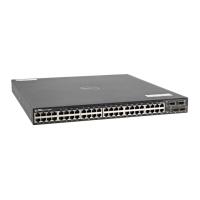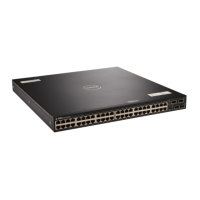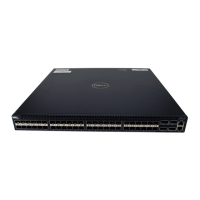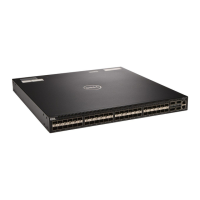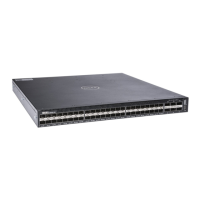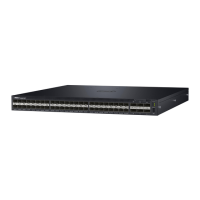15 MCAST 0 0 0 0
16 MCAST 0 0 0 0
17 MCAST 0 0 0 0
Dell#
Pre-Calculating Available QoS CAM Space
Before Dell Networking OS version 7.3.1, there was no way to measure the number of CAM entries a
policy-map would consume (the number of CAM entries that a rule uses is not predictable; from 1 to 16
entries might be used per rule depending upon its complexity). Therefore, it was possible to apply to an
interface a policy-map that requires more entries than are available. In this case, the system writes as
many entries as possible, and then generates an CAM-full error message (shown in the following
example). The partial policy-map configuration might cause unintentional system behavior.
%EX2YD:12 %DIFFSERV-2-DSA_QOS_CAM_INSTALL_FAILED: Not enough space in L3
Cam(PolicyQos) for class 2 (TeGi 12/20) entries on portpipe 1
The test cam-usage command allows you to verify that there are enough available CAM entries before
applying a policy-map to an interface so that you avoid exceeding the QoS CAM space and partial
configurations. This command measures the size of the specified policy-map and compares it to the
available CAM space in a partition for a specified port-pipe.
Test the policy-map size against the CAM space for a specific port-pipe or all port-pipes using these
commands:
• test cam-usage service-policy input policy-map {stack-unit } number port-set
number
• test cam-usage service-policy input policy-map {stack-unit } all
The output of this command, shown in the following example, displays:
• The estimated number of CAM entries the policy-map will consume.
• Whether or not the policy-map can be applied.
• The number of interfaces in a port-pipe to which the policy-map can be applied.
Specifically:
• Available CAM — the available number of CAM entries in the specified CAM partition for the specified
line card or stack-unit port-pipe.
• Estimated CAM — the estimated number of CAM entries that the policy will consume when it is
applied to an interface.
• Status — indicates whether the specified policy-map can be completely applied to an interface in the
port-pipe.
– Allowed — indicates that the policy-map can be applied because the estimated number of CAM
entries is less or equal to the available number of CAM entries. The number of interfaces in the
port-pipe to which the policy-map can be applied is given in parentheses.
– Exception — indicates that the number of CAM entries required to write the policy-map to the
CAM is greater than the number of available CAM entries, and therefore the policy-map cannot be
applied to an interface in the specified port-pipe.
NOTE: The show cam-usage command provides much of the same information as the test cam-
usage
command, but whether a policy-map can be successfully applied to an interface cannot be
determined without first measuring how many CAM entries the policy-map would consume; the
test cam-usage command is useful because it provides this measurement.
Quality of Service (QoS)
811
